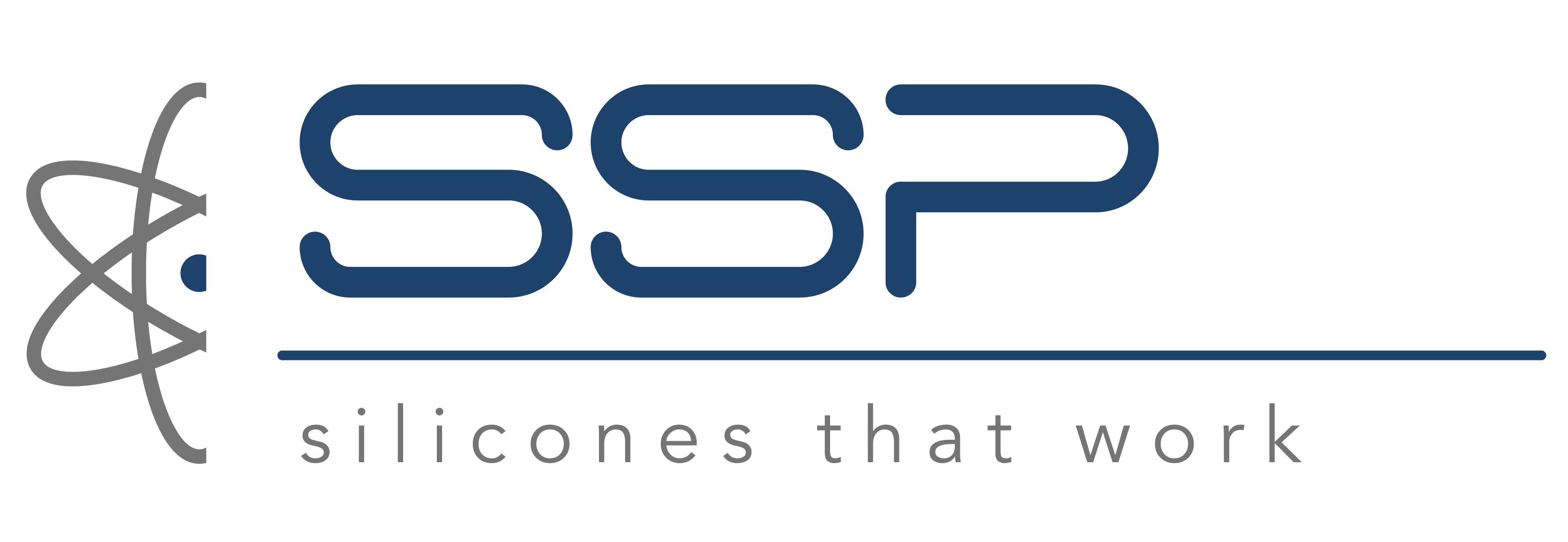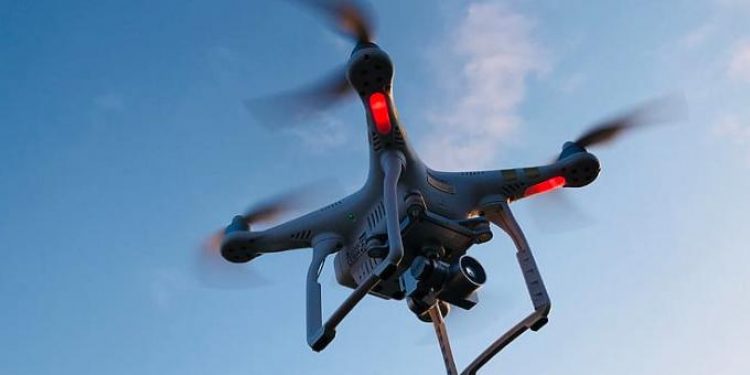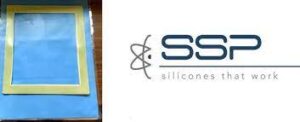UAV EMI shielding protects the electronics in unmanned aerial systems (UAV) from electromagnetic interference. (EMI). The causes of EMI are numerous and include intentional electronic jamming and unintentional interference from nearby electronics and electrical equipment.
Why Do UAVs Need EMI Shielding?
EMI shielding for UAVs protect sensitive circuits from electromagnetic interference that can degrade or disrupt performance. Typically, the circuits in a UAV are part of a printed circuit board (PCBA) that’s housed within a box-like enclosures.
At the board level, specialized EMI adhesives may be used. At the enclosure level, specialized EMI paints or coatings can be applied to surfaces to impart or improve shielding levels. Some enclosures are made of lightweight, electrically-conductive metals; however, most UAV structures are made of plastics or carbon fiber composites instead.
Regardless of the material, enclosures have tiny gaps between mating surfaces. Unless these gaps are filled, the circuits inside the enclosure may radiate or receive signals that cause interference. These gaps can also expose circuits to outdoor environments. That’s why EMI gaskets made of conductive elastomer materials are also used.
Why Do UAV Designers Need EMI Silicones?
Silicone elastomers resist water, moisture, and sunlight while providing both high-temperature and low-temperature resistance. When they are filled with metal, metal-coated, or bimetallic particles, these specialized elastomers also provide electrical conductivity. These materials can be fabricated into compressible, gap-filling gaskets that provide EMI shielding and environmental sealing.
Why Does EMI Shielding Matter in UAVs?
Modern UAVs are essentially flying sensor and communication platforms. They rely on a tightly integrated network of components such as flight controllers, GNSS receivers, antennas, telemetry systems, cameras, and payload electronics. These components must operate in harmony in complex and noisy electromagnetic environments.
EMI occurs when electromagnetic energy from one source disrupts or degrades the operation of another. This interference can be radiated (transmitted through space) or conducted (transmitted through wiring and power lines).
For UAV systems, EMI can lead to:
Navigation errors: Spurious signals can affect GNSS receivers and inertial measurement units, leading to drift or flight path deviation.
Communication loss: Interference can degrade radio links, causing dropouts or reduced range.
Sensor errors: Payload instruments, including LIDAR, radar, or multispectral cameras, are sensitive to noise.
Flight instability: Disrupted flight controllers can lead to erratic behavior or system resets.
Regulatory non-compliance: UAVs must meet emissions standards set by regulatory agencies to avoid interfering with other spectrum users.
For example, during early test flights of NASA’s Ingenuity (helicopter), EMI suppression around the onboard sensors was crucial to maintain stable flight control and reliable telemetry on Mars.
What are the Sources of EMI in UAV Systems?
EMI can originate from both internal and external sources:
Internal Sources
Brushless DC motors and ESCs: High-speed switching creates broadband noise.
Switching power supplies: Buck/boost converters emit high-frequency harmonics.
Onboard radios: Transmitters can interfere with each other and nearby circuits.
Digital electronics: High-speed processors and buses generate switching noise.
External Sources
Nearby transmitters: Ground stations, radar installations, and cellular towers.
Natural phenomena: Lightning or solar activity.
Other UAVs: Especially relevant in multi-vehicle swarm operations.
Because UAVs are compact and densely packed, internal EMI is often more problematic than external sources. Components are physically close, which increases coupling paths between noise sources and sensitive circuits.
What about Military UAVs and the War in Ukraine?
Russian electronic warfare has destroyed or disabled 90% of Ukraine’s drones, according to Forbes magazine. Some of these unmanned aerial vehicles (UAVs) were fixed-wing aircraft, but many were small quadcopters and octocopters. Multi-rotor drones are the most popular type of UAV today, and they have many civilian applications, such as power-line and pipe inspections, that range far beyond the battlefield.
Whether UAVs are designed for military or civilian use, and whether electromagnetic interference (EMI) is intentional or incidental, drones need protection from EMI to ensure their safe, reliable operation. For UAV designers and manufacturers, meeting this need is an important part of capturing more of a global market that will reach $70.91 billion by 2030, according to Allied Market Research.
What are Some EMI Shielding Design Strategies for UAVs?
Material choice alone is not sufficient—system-level design is key to effective EMI control in UAVs.
Grounding and Bonding
Ensure all metal components have a common ground reference.
Use low-impedance paths to shunt noise to ground.
Avoid ground loops, which can create new interference problems.
Shielded Enclosures
Place sensitive electronics in shielded compartments.
Use conductive gaskets to maintain shielding integrity at seams.
Isolate high-noise components like ESCs from sensitive payloads.
Cable Shielding and Routing
Use braided or foil shields on power and data cables.
Ground cable shields properly at one or both ends depending on the application.
Route noisy and sensitive cables separately to reduce coupling.
Filtering
Install EMI filters or ferrite beads on power lines.
Use common-mode chokes on communication lines.
Complement shielding with filtering for optimal results.
Aperture Control
Minimize openings in shielded enclosures.
Use waveguides below cutoff or EMI honeycomb vents for thermal management without compromising shielding.
System Partitioning
Physically and electrically separate subsystems according to their noise emission and susceptibility levels.
Use layered shielding approaches for critical avionics.
What are the Weight vs. Shielding Effectiveness Trade-offs?
Weight reduction is always a priority in UAV design. Traditional metal enclosures offer excellent shielding but may compromise flight time. Lightweight conductive coatings, fabrics, and conductive elastomers can reduce weight but may not offer the same broadband performance.
The optimal solution often involves hybrid shielding—combining different materials and techniques for specific frequencies and locations. For instance, a UAV might use a thin aluminum compartment for its flight controller, conductive coatings for payload electronics, and EMI gaskets for access panels.
Finite element analysis and EMI modeling tools help engineers predict performance before prototyping, reducing development cycles.
Testing and Standards for UAV EMI Shielding
UAV EMI performance must meet both internal quality goals and regulatory standards. Depending on application, relevant standards may include:
Federal Communications Commission Part 15 (for unintentional radiators)
RTCA DO-160 (environmental conditions and test procedures for airborne equipment)
International Electrotechnical Commission standards such as IEC 61000 series
Testing typically involves radiated and conducted emissions, radiated and conducted susceptibility, and shielding effectiveness measurements in anechoic or semi-anechoic chambers.
Who Supplies UAV EMI Shielding?
Specialty Silicone Products of Ballston Spa, New York (USA) makes conductive silicones for EMI gaskets that are used with UAVs. These specialized elastomers are available with silver-plated and nickel-graphite fills with proven levels of EMI shielding.
Importantly, many of these elastomers meet lettered requirements in the MIL-DTL-83528 specification, and some have a qualified product listing (QPL) from the U.S. Department of Defense.
Whether the application is civilian or military, SSP’s EMI elastomers are available as compression molded sheets, continuous rolls, or ready-to-mold compounds. UAV designers and manufacturers can also choose EMI O-rings, EMI extrusions, and custom-molded EMI gaskets.
To learn more about these SSP materials and products, contact SSP.





